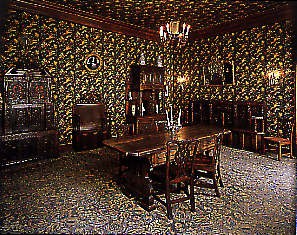It was in October 1832, that the Hugo family moved into this house in the Place Royale, today the Place des Vosges. The writer lived there until the Revolution of 1848. There he wrote an siginificant part of his oeuvre, namely: Les Chants du Crepuscule, 1835; Les Voix Intérieures, 1837; Ruy Blas, 1838; Les Rayons et les Ombres, 1840; Les Burgraves, 1843; part of Les Misérables and the beginning of La Légende des Siècles.
The former Hôtel Rohan-Guéménée built around 1604, Hugo's house has been greatly modified since the time when the Hugo family lived there. Curators of the museum have restored the apartment to the way it looked when Hugo lived there, and this can be viewed in the General Guide to the Home of Victor Hugo. The museum was founded in 1902 from the collection of Paul Meurice, close friend and executor of the poet's estate.
Today, visitors enter the museum via the antechamber and then the salon, where there is a display of memorabilia relateed to Victor Hugo's family, notably his grandparents, his father Leopold Hugo (shown in his Général d'Empire uniform), his mother Sophie Trébuchet, and his brothers, Abel and Eugène. His childhood, his growing love for Adèle Foucher, their marriage in 1822, and the birth of their four children Léopoldine, Charles, François-Victor and Adèle are all evoked through various objects, including busts, paintings, drawings and other items. Also on show is a drawing done by the writer himself of the coat of arms which he adopted in 1845 when he was made Pair de France (a peerage). The arms comprise those of the Hugo de Lorraine family and those of his father, who received the rank of count in July 1810 following his victory over a Spanish guerilla leader at Sigûenza. Also worthy of note is a chest engraved and painted by Hugo which bears the initials of his son, François-Victor, who worked with his father on the journal L'Evenement. This journal ardently supported the the candidacy of Louis-Napoleon Bonaparte in 1848, and tradition has it that the future Prince-President sat on the chest during a visit to the illustrious writer.
The following rooms are entirely dedicated to Hugo's exile. In 1851, the day after Napoleon III's coup d'etat, Hugo left France using a false passport. After a few months in Belgium, he moved to the Isle of Jersey and then to Guernsey, to Hauteville House, where he lived until the fall of the Second Empire in 1870. His faithful Mistress, Juliette Drouet, followed him and settled near the dwelling of the Hugos, at Hauteville Fairy. The interior decoration of the “Chinese” dining room of this house, made entirely by the writer himself, has been installed in the house in the Place des Vosges. It bears witness to Hugo's talent for decoration: all of the wooden panels were designed and engraved by his hand.
The next room contains a beautiful collection of photographs taken Charles Hugo and Auguste Vaquerie during the exile. They show the writer's daily life, as well as that of his family and the circle of coup d'etat exiles which had gathered around him, most interestingly Hugo's editor, Pierre-Jules Hetzel who published Napoléon le Petit (1852) and Châtiments (1853).
The visit finishes with the life of Victor Hugo after his return from exile and a restoration of the room in which he died. The Home of Victor Hugo regularly organizes exhibits of the graphic works of the writer. It is also home to an etching room and a library which is open to researchers by appointment.
Home of Victor Hugo


